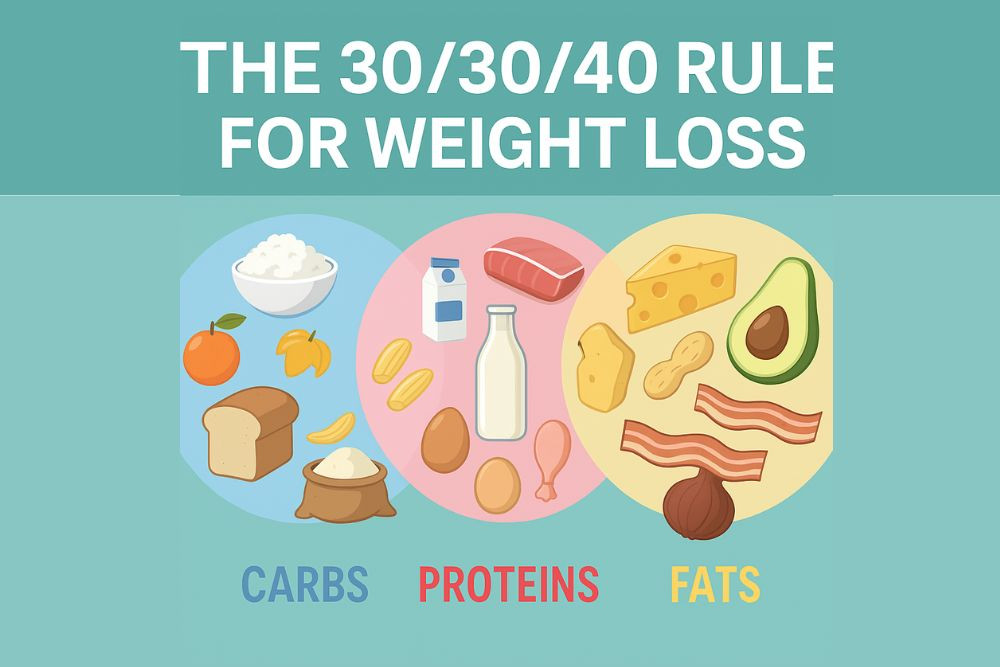The 30/30/30 Rule for Weight Loss: A Comprehensive Guide
Building Your 30/30/30 Action Plan: Practical Steps to Get Started
Weight loss can often feel like navigating a maze. With countless diets, workouts, and expert advice flooding the wellness space, it’s easy to feel overwhelmed. Enter the 30/30/30 rule—a straightforward, balanced approach to achieving sustainable weight loss. This method focuses on equal parts diet, exercise, and mindset, offering a holistic framework for those seeking lasting results. The 30/30/30 rule provides clarity and a roadmap for success by breaking down the process into manageable components.
In this blog, we’ll explore the components of the 30/30/30 rule, the science behind its effectiveness, and actionable tips to implement it into your lifestyle. If you’ve been searching for a realistic and practical way to shed pounds, this guide is for you.
What is the 30/30/30 Rule?
The 30/30/30 rule is a balanced approach to weight loss that divides your efforts into three equal components:
- 30% Diet: Focus on innovative and sustainable eating habits.
- 30% Exercise: Engage in physical activities that suit your goals and preferences.
- 30% Mindset: Cultivate the mental resilience and habits necessary for long-term success.
Each segment is integral, and neglecting one can hinder your progress. Let’s break down each component and understand how it contributes to weight loss.
30% Diet: Fuel Your Body Wisely
Diet is arguably the cornerstone of any weight loss strategy. Creating a caloric deficit—burning more calories than you consume—is essential for shedding pounds. However, this doesn’t mean resorting to crash diets or extreme restrictions. The 30/30/30 rule emphasizes sustainable eating habits that nourish your body while promoting weight loss.
Tips for a Balanced Diet:
- Prioritize Whole Foods: Opt for minimally processed foods like fruits, vegetables, lean proteins, whole grains, and healthy fats. These provide essential nutrients and keep you satiated longer.
- Portion Control: Even healthy foods can lead to weight gain if consumed excessively. Use tools like measuring cups or your hand to guide portion sizes.
- Limit Added Sugars: High-sugar foods and beverages can lead to calorie overload without providing much nutritional value. Choose water, herbal teas, or black coffee instead.
- Plan Your Meals: Meal prepping ensures you have nutritious options readily available, reducing the temptation to order takeout or reach for unhealthy snacks.
- Practice Mindful Eating: Pay attention to hunger and fullness cues. Eat slowly and savor each bite to avoid overeating.
Sample Meal Plan:
- Breakfast: Greek yogurt with berries and a sprinkle of granola.
- Lunch: Grilled chicken salad with mixed greens, avocado, and olive oil dressing.
- Snack: A handful of almonds or an apple with peanut butter.
- Dinner: Baked salmon, quinoa, and steamed broccoli.
- Dessert: A square of dark chocolate or a small bowl of fresh fruit.
30% Exercise: Move with Purpose
Physical activity burns calories, improves overall health, builds muscle, and boosts metabolism. The exercise component of the 30/30/30 rule encourages a combination of cardio, strength training, and active daily habits.
Key Types of Exercise:
- Strength Training: Building lean muscle increases your resting metabolic rate, helping you burn more calories even at rest. Include exercises like squats, deadlifts, and push-ups in your routine.
- Cardiovascular Exercise: Running, cycling, and swimming improve heart health and torch calories. Aim for at least 150 minutes of moderate-intensity cardio per week.
- Flexibility and Recovery: Yoga, Pilates, and stretching enhance flexibility, reduce the risk of injury, and promote relaxation.
- Daily Movement: Incorporate small changes into your day, such as walking instead of driving, taking the stairs, or doing chores. These activities add up and contribute to your overall energy expenditure.
Sample Weekly Workout Plan:
- Monday: Full-body strength training (45 minutes).
- Tuesday: 30-minute brisk walk or jog.
- Wednesday: Yoga or stretching session (30 minutes).
- Thursday: High-intensity interval training (HIIT) workout (20 minutes).
- Friday: Rest or light activity (e.g., a short walk).
- Saturday: Long cardio session (e.g., hiking or cycling for an hour).
- Sunday: Active recovery with stretching or a leisurely swim.
30% Mindset: The Mental Game
Mindset is the often-overlooked cornerstone of successful weight loss. Developing a positive and resilient attitude ensures consistency and motivation, even when progress feels slow or obstacles arise.
Strategies for a Strong Weight Loss Mindset:
- Set Clear Goals: Define both short-term and long-term goals. For example, aim to lose 5 pounds in a month or run a 5K by the end of the year.
- Practice Visualization: Spend a few minutes each day imagining yourself achieving your weight loss goals. Picture how you’ll feel, look, and live once you reach them.
- Use Affirmations: Repeat positive statements like, "I am committed to my health" or "Every day, I’m making progress."
- Track Your Progress: Keep a journal or use an app to log your meals, workouts, and thoughts. Seeing your achievements over time can be incredibly motivating.
- Develop Resilience: Understand that setbacks are part of the process. Instead of viewing them as failures, see them as opportunities to learn and improve.
- Find Support: Surround yourself with people who encourage and uplift you. This could be friends, family, or even an online community of like-minded individuals.
The Science Behind the 30/30/30 Rule
The 30/30/30 rule isn’t just a catchy concept; it’s grounded in science. Here’s why this balanced approach works:
- Diet and Caloric Deficit: Weight loss occurs when you consume fewer calories than your body burns. However, extreme dieting can lead to nutrient deficiencies and rebound weight gain. A balanced diet ensures sustainable progress.
- Exercise and Metabolism: Physical activity increases your total daily energy expenditure. Strength training, in particular, preserves muscle mass, which prevents metabolic slowdowns often associated with weight loss.
- Mindset and Behavior Change: Studies show that a positive mindset and strong self-efficacy predict weight loss success. Developing mental resilience helps you overcome challenges and maintain healthy habits.
How to Start the 30/30/30 Rule
If you’re ready to embrace the 30/30/30 rule, follow these steps:
- Evaluate Your Habits: Identify areas where you can improve your diet, exercise routine, and mindset.
- Set Specific Goals: Write down measurable objectives for each component.
- Create a Plan: Develop a weekly schedule for meals, workouts, and mindset practices.
- Monitor Progress: Regularly track your efforts and make adjustments as needed.
- Be Patient: Remember, sustainable weight loss takes time. Focus on consistency over perfection.
Transform Your Life Today
The 30/30/30 rule for weight loss offers a sustainable, balanced approach to achieving your health goals. By focusing equally on diet, exercise, and mindset, you can create lasting habits supporting weight loss and overall well-being.
Ready to start your journey? At Cheval Wellness, we’re here to help you every step of the way. Our team of experts provides personalized wellness plans tailored to your unique needs. Contact us today and take the first step toward a healthier, happier you!





